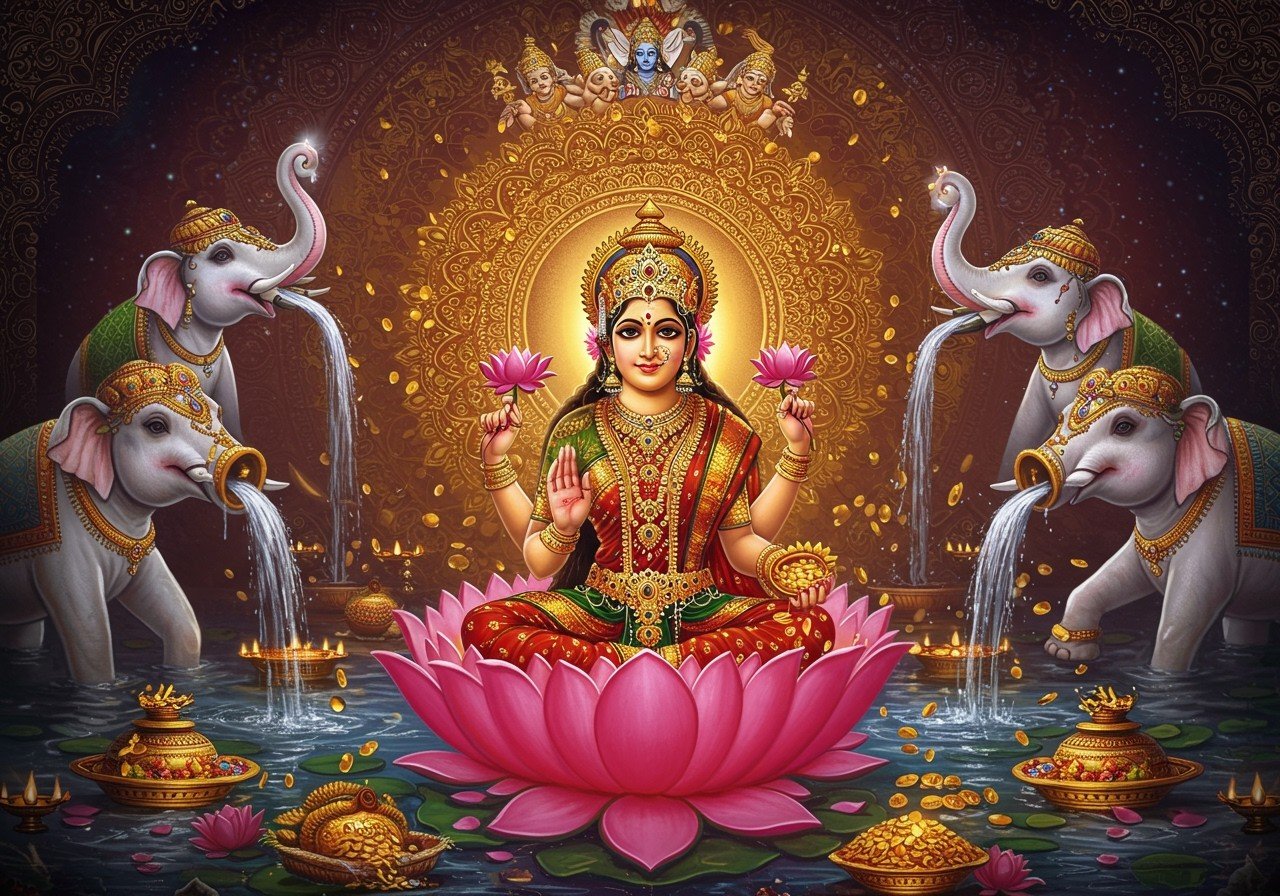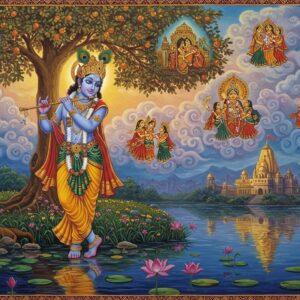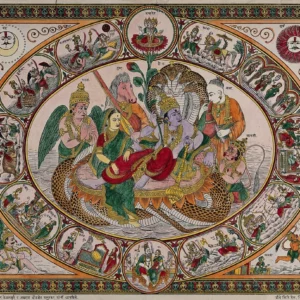
In the rich tapestry of Hindu mythology, Lakshmi stands out as the goddess of wealth, fortune, and prosperity. Her stories, passed down through generations, symbolize abundance, purity, and auspiciousness. Understanding Lakshmi’s tales not only enhances spiritual knowledge but also enriches cultural traditions that remain significant in modern Indian society. As one of the principal goddesses in Hinduism, Lakshmi is revered for bestowing wealth, fortune, power, beauty, and abundance. Along with Parvati and Saraswati, Lakshmi forms the Tridevi, the trinity of goddesses.
The Birth of Lakshmi: Emerging from the Cosmic Ocean
Lakshmi’s birth is a pivotal event in Hindu cosmology. The most prevalent myth describes her emergence during the Samudra Manthan, the Churning of the Ocean. Gods and demons, striving for amrita, the nectar of immortality, churned the Kshira Sagar (ocean of milk). Amidst this cosmic event, Lakshmi arose from the waves, fully grown and seated on a lotus, a symbol of purity and abundance. Some accounts consider Lakshmi the daughter of the sea god due to her oceanic origins. Other texts, such as the Garuda Purana, Linga Purana, and Padma Purana, narrate her birth as Bhargavi, daughter of sage Bhrigu and his wife Khyati.
This divine emergence highlights her significance among other treasures like the moon and the divine elephant, Airavata. Lakshmi’s birth is particularly celebrated during Diwali, the festival of lights, where devotees invoke her blessings for wealth and prosperity. On Lakshmi Puja, rituals honor her, seeking her grace for a prosperous future. The churning process itself symbolizes the hard work and perseverance that lead to success and prosperity.
Lakshmi’s Marriage to Vishnu: A Divine Union
Lakshmi’s marriage to Vishnu is a cornerstone of Hindu cosmology. Their union embodies the balance between wealth and sustenance. Vishnu, the preserver of the universe, finds harmony with Lakshmi’s prosperity and fortune. This divine partnership reflects the ideal of a balanced life where material wealth complements spiritual growth. Whenever Vishnu incarnates on Earth, Lakshmi accompanies him as his consort. As Sita, she stands by Rama; as Radha or Rukmini, she is with Krishna. These varied manifestations of Lakshmi highlight her adaptable nature and unwavering devotion to her divine consort. Her presence emphasizes the significance of feminine energy in the universe.
This narrative inspires many Indian wedding customs, reflecting devotion, choice, and eternal companionship. During Lakshmi’s swayamvara, her self-choice ceremony, she chose Vishnu over other gods. This story underscores the themes of love, dedication, and the importance of individual choice.
Lakshmi and Vishnu: Tales of Separation and Reunion
Lakshmi’s temporary departures from Vishnu are replete with moral teachings. In stories like the Bhasmasura episode, Lakshmi leaves due to Vishnu’s actions or to uphold dharma, righteousness. These narratives offer profound lessons about the consequences of our actions and the importance of adhering to ethical principles. They also explore the dynamics of relationships, demonstrating that separation can lead to deeper understanding and a stronger reunion. One such story involves Lakshmi leaving Vaikuntha, her heavenly abode, after a disagreement with Vishnu. She sought refuge in a hermitage on the banks of the River Godavari, highlighting the importance of personal space and reflection even in divine relationships. Vishnu, realizing her absence, searched for her, ultimately leading to their reconciliation and reaffirming the strength of their bond.
Symbolically, Lakshmi’s departure represents the cyclical nature of abundance and scarcity in life. These tales remind us that wealth and fortune can fluctuate, teaching us resilience, gratitude, and the importance of non-attachment to material possessions. In another instance, Lakshmi, feeling neglected by Vishnu, resided with King Akasha Raja in southern India, taking the name Padmavati. Vishnu, disguised as Shrinivas, eventually found her, illustrating the lengths to which love can endure separation and misunderstanding.
Lakshmi’s Role in Hindu Festivals: Celebrations of Prosperity and Devotion
Festivals dedicated to Lakshmi unite communities in celebrations of prosperity and devotion. Diwali, the festival of lights, and Kojagiri Purnima are prominent examples. These festivals emphasize spiritual practices like lighting lamps, offering prayers, and sharing sweets to invoke Lakshmi’s blessings. During these times, rituals focus on devotion, seeking Lakshmi’s blessings for wealth, happiness, and overall well-being. People decorate their homes, wear new clothes, and prepare special dishes to welcome the goddess into their lives.
Different regions of India celebrate Lakshmi with unique traditions, reflecting the country’s rich cultural diversity. From the elaborate rituals of South India to the vibrant festivities in the North, Lakshmi’s presence is felt throughout the nation. In today’s digital age, these festivals are embracing modernity. Online shopping and gifting are becoming integral parts of the celebrations, blending tradition with convenience. Poojn.in offers a convenient way to purchase authentic puja items for these celebrations, allowing individuals to connect with their cultural roots while enjoying the ease of online shopping.
Iconography and Symbolism of Lakshmi: A Visual Language of Abundance
Lakshmi’s depiction in art is rich with symbolism. She is often portrayed seated or standing on a lotus, representing purity and detachment from worldly desires. Her four arms symbolize dharma (righteousness), artha (wealth), kama (desire), and moksha (liberation), representing the four goals of human life in Hindu philosophy. The overflowing pot of gold coins signifies abundance and prosperity, while the elephants flanking her represent royal power and wisdom. Sometimes depicted with owls, symbols of foresight and wisdom, Lakshmi’s iconography emphasizes the importance of intelligent decision-making in managing wealth.
Lakshmi’s imagery is prevalent in household decor and commercial designs, educating and inspiring devotion across generations. These symbols serve as constant reminders of her cultural significance and timeless wisdom. They also act as visual cues to invoke her blessings and cultivate positive energy within homes and businesses. These images connect individuals with their cultural heritage and strengthen their faith in the goddess.
How Poojn Helps You Honor Goddess Lakshmi
Poojn.in (https://poojn.in) offers authentic puja items to enhance your Lakshmi worship with proper rituals and devotion. Our collection includes:
- Pure brass and silver Lakshmi idols crafted in traditional designs https://www.poojn.in/product/9392/maa-lakshmi-8-astadhatu-brass-laxmi-mata-murti-pure-pital-brass-lakshmi-mata-murti. These idols serve as a focal point for devotion and meditation, helping devotees connect with the divine energy of Lakshmi.
Each idol is crafted with meticulous detail to ensure authenticity and spiritual significance. - Complete Lakshmi puja sets containing all the essential items for a traditional ceremony. These sets provide convenience and ensure that all the necessary components are readily available for devotees. The sets include items such as diyas, incense, and offerings, allowing for a comprehensive and fulfilling puja experience.
- Red cloth and asanas specifically designed for Lakshmi worship. Red is considered an auspicious color associated with Lakshmi, symbolizing prosperity and power. The red cloth and asanas create a sacred space for the puja, enhancing the spiritual atmosphere and inviting Lakshmi’s blessings.
- Pure copper kalash and panchpatra for ritual offerings, essential components of traditional Hindu ceremonies. Copper is believed to have purifying properties, making it ideal for holding sacred water and offerings. The kalash and panchpatra add a touch of authenticity to the puja, enhancing its sacredness.
- Traditional lotus-shaped diyas and oil lamps to illuminate your altar and create a serene atmosphere during Lakshmi Puja. The lotus, a symbol of purity and enlightenment, adds a symbolic dimension to the lighting of the lamps, creating a spiritually uplifting environment.
- Natural cotton wicks and pure ghee for aarti. Pure ingredients enhance the sanctity of the rituals, fostering a deeper connection with the divine.
- Fresh kumkum, haldi, and other ritual powders. These traditional ingredients are essential for various puja rituals, symbolizing blessings and auspiciousness. Using fresh powders adds to the purity and authenticity of the ceremonies.
- Authentic incense sticks and dhoop for puja. The fragrant smoke purifies the atmosphere and creates a sacred space conducive to prayer and meditation. It elevates the spiritual experience of the Lakshmi puja.
We source our products directly from trusted artisans and manufacturers, ensuring quality and authenticity. Each item adheres to traditional specifications for religious use. Our puja items are carefully packed and delivered across India. Explore our complete collection at https://poojn.in/collections/lakshmi-puja. We provide detailed product descriptions and fast delivery to help you maintain proper worship practices at home.
Note: Prices and availability of items may vary. Please check the website for current details.
Embracing Lakshmi’s Legacy: A Timeless Guide to Prosperity
Lakshmi’s myths and legends offer a rich tapestry of lessons for navigating life’s complexities. Her stories impart wisdom about love, devotion, and the balance between material wealth and ethical values. By celebrating Lakshmi through festivals and rituals, we connect with our cultural roots and gain valuable spiritual insights. These practices strengthen our sense of community and pass down traditions to future generations.
Lakshmi’s presence in our homes, through art and symbols, serves as a constant reminder of her blessings and the virtues she embodies. Her timeless wisdom inspires gratitude, resilience, and the pursuit of righteousness. By embracing Lakshmi’s legacy, we honor tradition while welcoming the conveniences of modern life, ensuring prosperity and happiness for generations to come. This balanced approach allows us to benefit from technological advancements while preserving the cultural and spiritual values that enrich our lives.
FAQs about Lakshmi
How was Lakshmi born? Lakshmi emerged from the ocean during Samudra Manthan, the churning of the cosmic ocean, a key event in Hindu mythology involving gods and demons competing for amrita, the nectar of immortality.
When did Lakshmi marry Vishnu? Lakshmi chose Vishnu as her consort during a swayamvara, a ceremony where a bride chooses her husband, after emerging from the ocean. Their union symbolizes the ideal balance between material and spiritual aspects of life.
Why did Lakshmi leave Vishnu? Various stories depict Lakshmi leaving Vishnu, often to uphold dharma or as a consequence of his actions, teaching valuable lessons about righteousness and consequences. These departures highlight the complexities of relationships, even divine ones, and underscore the importance of balance and respect.
What does Lakshmi symbolize? Lakshmi symbolizes wealth, prosperity, fortune, beauty, fertility, and auspiciousness. She represents the abundance and blessings that flow from righteous living and devotion.
How is Lakshmi depicted in Hindu art? Lakshmi is typically depicted seated or standing on a lotus flower, symbolizing purity and detachment. She often has four hands, holding lotus buds and sometimes coins, representing wealth and purity. Her serene expression conveys her divine grace and blessings.
What are the key festivals dedicated to Lakshmi? Diwali, the festival of lights, and Lakshmi Puja are major celebrations honoring Lakshmi. Devotees perform rituals and offer prayers seeking her blessings for wealth, happiness, and prosperity.
How does Lakshmi influence daily life in Hindu culture? Lakshmi’s influence extends to daily life, encouraging values like hard work, generosity, and ethical conduct. Her presence is invoked for success and abundance in various endeavors.


